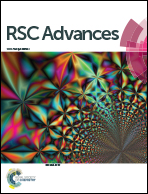Photothermal response of the plasmonic nanoconglomerates in films assembled by electroless plating†
Abstract
Photothermal transduction of light to heat by evaporated and electroless plated gold (Au) films has been compared. Bare film was compared to film decorated by an ordered lattice of Au nanocylinders. The effects of plasmonic absorption of incident light, heat dissipation in the substrate, and interfacial effects between Au nanoparticles and the substrate were evaluated. Differences in the photothermal response of the films emerged due to interactions between these effects. Significant photothermal transduction was achieved by 30–40 nm Au grains as well as by conglomerate nanocylinders assembled from Au grains. An electroless Au film decorated with conglomerate Au nanocylinders ordered into a hexagonal array enhanced attenuation by 22% and increased light-to-heat conversion by 26%. This was attributed to photon-plasmon coupling. An evaporated Au film of 57 nm thickness attenuated 30% of incident light, compared to 45% attenuation for the electroless film of 35 nm thickness. The evaporated film had a photothermal response of 280 °C per watt of incident light in contrast to 1400 °C per watt for the electroless film.


 Please wait while we load your content...
Please wait while we load your content...